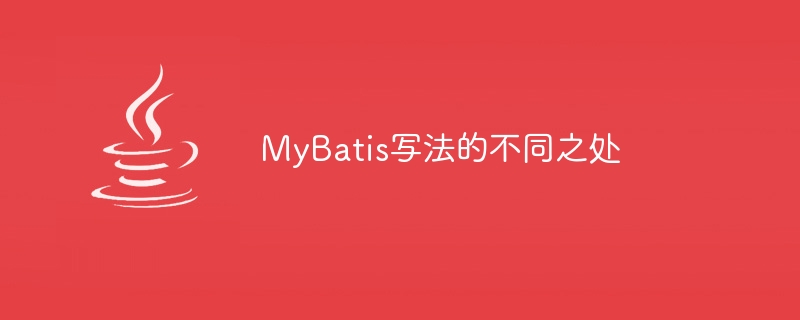

The difference in how MyBatis is written requires specific code examples
Overview:
MyBatis is a lightweight, persistence layer framework that is different from other ORMs Compared with frameworks, MyBatis has some differences in writing methods. This article will introduce in detail the different writing methods of MyBatis and provide some specific code examples.
1. Use of XML mapping files:
The core of MyBatis is to execute SQL statements through XML mapping files. Compared with other ORM frameworks, the use of XML mapping files separates SQL statements from Java code, improving the readability and maintainability of the code.
Example: Suppose there is a User class.
1.1 Configure XML mapping file:
<!-- User.xml -->
<mapper namespace="com.example.UserMapper">
<select id="getUserById" resultType="com.example.User">
SELECT * FROM users WHERE id = #{id}
</select>
</mapper>1.2 Call in Java code:
@Autowired
private SqlSession sqlSession;
public User getUserById(int id){
UserMapper userMapper = sqlSession.getMapper(UserMapper.class);
return userMapper.getUserById(id);
} 2. Use of dynamic SQL:
MyBatis provides a convenient To construct dynamic SQL statements, you can splice SQL statements according to different conditions and dynamically generate the final SQL statement during execution. This writing method is very flexible and convenient in practical applications.
Example: Suppose there is a User class.
2.1 Use if tag:
<!-- User.xml -->
<mapper namespace="com.example.UserMapper">
<select id="getUserByCondition" resultType="com.example.User">
SELECT * FROM users WHERE 1 = 1
<if test="id != null">
AND id = #{id}
</if>
<if test="name != null">
AND name = #{name}
</if>
</select>
</mapper>2.2 Call in Java code:
@Autowired
private SqlSession sqlSession;
public List<User> getUserByCondition(Integer id, String name){
UserMapper userMapper = sqlSession.getMapper(UserMapper.class);
return userMapper.getUserByCondition(id, name);
} 3. Use of result mapping:
MyBatis supports mapping query results to Java For objects or customized result sets, the mapping relationship can be specified by configuring an XML mapping file.
Example: Suppose there is a User class.
3.1 Automatic mapping:
<!-- User.xml -->
<mapper namespace="com.example.UserMapper">
<resultMap id="userResultMap" type="com.example.User">
<id property="id" column="id" />
<result property="name" column="name" />
</resultMap>
<select id="getUserById" resultMap="userResultMap">
SELECT * FROM users WHERE id = #{id}
</select>
</mapper>3.2 Calling in Java code:
@Autowired
private SqlSession sqlSession;
public User getUserById(int id){
UserMapper userMapper = sqlSession.getMapper(UserMapper.class);
return userMapper.getUserById(id);
}Summary:
MyBatis is a flexible and powerful persistence layer framework, through XML mapping files can easily manage SQL statements. The construction of dynamic SQL statements can flexibly splice SQL statements according to different conditions. The use of result mapping can map query results to Java objects or custom result sets. These differences make MyBatis a persistence layer framework that developers like.
The above is the detailed content of Different MyBatis writing characteristics. For more information, please follow other related articles on the PHP Chinese website!
 SQL statement to backup database
SQL statement to backup database
 What file is windows.old?
What file is windows.old?
 Introduction to win11 screenshot shortcut keys
Introduction to win11 screenshot shortcut keys
 How to close the window opened by window.open
How to close the window opened by window.open
 Douyin level price list 1-75
Douyin level price list 1-75
 The computer system consists of
The computer system consists of
 What are the differences between c++ and c language
What are the differences between c++ and c language
 How to find the location of a lost Huawei phone
How to find the location of a lost Huawei phone




